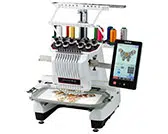Loading ...
Loading ...
Loading ...

APPENDIX
251
7
The various precautions concerning the thread, embroidery frames and stabilizers (backings) that must be
observed in order to create beautiful embroidery are described below.
Threads
Embroidery thread can be costly, therefore caring
for it should be a priority. No matter how well a
thread is manufactured, it must be appropriately
stored if it is to sew properly. This is especially true
when one considers the time that lapses between
delivery to the thread user and the moment the
thread is actually used on the embroidery
machine. It is important that embroidery threads
be stored in an environment that is free of
damaging agents such as excessive heat, light or
moisture.
Embroidery threads are best stored in an area that
is as clean and dust-free as possible. It is also
important that the storage area be free of smoke,
fumes and gases. Certain gases may cause the
thread to yellow. These fumes originate from such
appliances as gas heaters or from gas or diesel
engines.
Direct sunlight is also extremely destructive for
embroidery threads. Boxes of thread should not be
left open and exposed to direct sunlight. If
possible, skylights and windows should be
diffused. The best type of lighting for embroidery
thread is tungsten-filament or fluorescent tubes. It
is important to remember that prolonged exposure
to these harmful sources may also cause the colors
of cardboard boxes and other objects to fade.
Temperature and humidity also pose a threat to
embroidery threads. The ideal conditions are
between 59
°F and 77 °F (or 15 °C and 25 °C).
Humidity should be between 40% and 60%.
These conditions should be kept as constant as
possible in order to prevent mildew from forming.
Excessive temperatures can also cause lubrication
problems that ultimately result in thread breaks.
Damp conditions can affect paper bobbins as the
cardboard will swell and the thread can become
oversized. It is also important to realize that even if
the overall storage conditions are good, there may
be “spot problems” where a thread is exposed to a
heat source or bright lights. Ensuring that thread
does not become damaged requires that stock be
frequently rotated and that threads are not left in
the same place for an extremely long time.
Choice of thread is a major factor in improving
production time. The thread run ability, strength,
consistency and weight all affect output. These
qualities determine how well the machine will
sew and the number of thread breaks during
sewing.
Thread breaks have an important influence on
production. Each thread break reduces output by
at least 0.07% a day (7.5 hours), assuming that it
takes 20 seconds to rethread a needle. For every
reduction of 14 thread breaks per a day, output
can be improved by more than 1.0 %.
Stabilizers (backing)
Backing and topping serve to stabilize and support
the product being embroidered so the stitches can
be sewn with the least amount of interference or
instability. They serve as stabilizers for your
embroidery work. Without the proper type of
stabilizer, the fabric may move too much within
the embroidery frame causing poor alignment of
the embroidery. At times, topping will be required
in order to manage fabrics with a pile-like surface,
such as towels, corduroy and piqué knit. There are
many types of backing and toppings with various
weights for the various fabrics that you may be
sewing.
There are four types of stabilizers (backing) that
can be used in embroidery: cut-away, tear-away,
water soluble and self-adhesive. In these four
types, various weights, sizes and textures are
available. When selecting the stabilizer type for a
particular fabric, consider the design size in
addition to the stitch count and stitch type used in
the design.
Finally, make sure that the stabilizer is not
stretched. Some backings may not stretch
vertically or horizontally but may stretch
diagonally. DO NOT USE THESE TYPES. This type
of backing will stretch during sewing and may
cause the design to shift.
Creating Beautiful Embroidery
Loading ...
Loading ...
Loading ...
